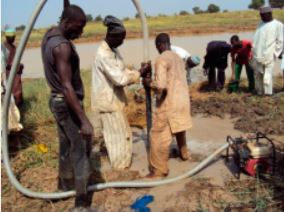


A technique used to sink wells more easily, more rapidly and to a greater depth than hand-dug or driven wells (See Sheets E29 and E30).
A bored well is a cylindrical hole sunk vertically by percussion or the rotary action of a cutting tool (auger, drill bit) turning around a vertical axis.
The diameter of a bored well can vary from 5 cm and 1.5 m.
Nearly all these wells are normally fitted with a water pump.
The pump (manual, motor-driven, submersible) is chosen according to the well depth, the desired operating flow rate and the resources (technical, financial and logistical) that are potentially available.
(See Sheets E35 to E43 on the various types of pump)
A borehole is an ancient technique dating back over three thousand years. It originated in China where bits of bamboo attached to a heavy weight were used to drill water wells.
There are two main approaches to boreholes these days :
- Manual drilling using manual tools for fairly shallow wells up to 40 m deep.
- Mechanised drilling using light equipment or a drilling platform and heavy equipment which can reach great depths.
In some cases, the mechanised drilling machines are fitted on self-propelled mobile platforms that are much quicker and easier to use and which can drill into hard ground at great depth. They are however far more cumbersome.
Comment : the mechanised drilling machines are often too expensive for the poorest populations in rural or near-urban areas. Manual drilling techniques must not be ignored, even if they are slower and rather more tiring.
Manual drilling is a practical solution that, although tiring, is advantageous and inexpensive for water points less than 40 metres deep in soft ground such as clay or sand and soft rock like soft sandstone or limestone. Where the characteristics of the ground permit, drilling a manual borehole can prove to be more than four times cheaper than a mechanised borehole.
But in hard ground, or when wishing to drill to a great depth or avoid difficult work or go faster and the means are available, mechanised boreholes and a better, even essential solution.
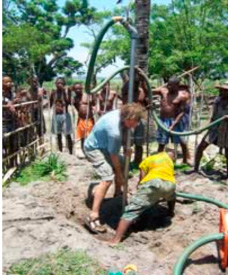

The cheaper manual boreholes are of interest to the NGOs and public authorities as these techniques can produce more wells. They also appeal to villages, small communities and farmers in rural areas with few resources as they can drill small boreholes themselves with a minimum of help and advice.
There are in fact numerous processes and it can be fairly difficult to distinguish between them given their sometimes curious names, which can also vary according to the engineered structures and the language used (often English).
The aim of this sheet is to describe and clarify the main processes by distinguishing between the manual boreholes and the mechanised boreholes. The drilling techniques most used or quoted are :
- manual mode : hand-auger drilling for communities with few resources, percussion or cable-tool drilling (up to 25 m) and rotary sludge drilling (also called mist or rotary manual drilling, up to 35 m).
- mechanised mode : compressed air percussion drilling (also called down-the-hole hammer drilling or rotary percussion drilling).
They are primarily used for their low cost price, for shallow depths and for sinking in relatively soft ground, although some techniques, such as compressed air percussion drilling or down-the-hole hammer drilling can bore into fairly hard ground.
Cheap manual tools are used (for example, gimlets called augurs which are turned with muscle power.
There are different techniques : The most frequently used are :
Hand-auger drilling – (Maximum depth of 25 metres)
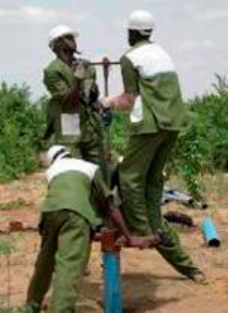

Hand-auger drilling involves turning a gimlet, or auger, with a large handle. Steel extensions are added as the auger is forced further into the ground. When the auger is filled with spoil, it is hauled up to be emptied and then the operation is repeated.
The borehole normally remains open above the level of the water table and does not require shoring up. A temporary preliminary well casing can be used when the water table is reached to prevent the borehole walls from collapsing. Drilling continues inside this preliminary well casing with a bailer until the desired depth is reached. The temporary well casing is then removed and the permanent casing inserted.
Hand-auger drilling can be used up to about 15 to 25 metres deep and in soft ground (sands, silts or clays).
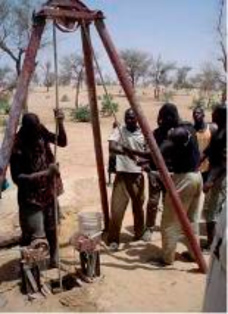

Percussion drilling (also known as stone hammer drilling)
(Max. depth : also 25 m)
In percussion drilling, a heavy cutting tool (the bit) is attached to a rope or cable then dropped under its own weight into the borehole. A tripod is used to raise the tool with the rope or cable. The bit breaks up the ground when it falls back down. Water is added to the hole which mixes with the spoil and turns it to mud. This mud shores up the borehole walls and raises the rock spoil but is also brought to the surface with a bailer.
The bit is raised and dropped in the hole as many times as necessary.
It is often necessary to use a mud column and more importantly preliminary well casing in plastic or preferably steel to prevent any risk of the hole collapsing, especially when the ground is soft.
The percussion (or stone hammer) technique is normally used for depths up to 25 metres for drinking water, but deeper boreholes can be drilled.
Percussion drilling can be combined with other drilling techniques like hand-auger drilling, which drills the first few metres of the borehole quickly as far as hard ground.
Jetting or washbore drilling
(Max. depth of 35 to 45 metres depending on the technique)
There are two jetting techniques :
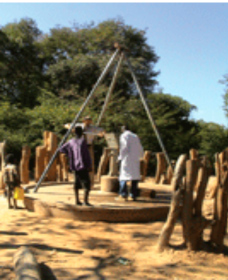

1) Rapid pressurised jetting or direct jetting (Max. depth : 35 m)
This technique is described in the sheet on driven wells. (See previous sheet E30)
The technique involves driving a pipe into the ground by pressurised injection of a large amount of water using a motor-driven pump or foot-operated pump. It is used for drilling shallow boreholes rapidly, most frequently in less than a day, at moderate cost.
Driven (or instantaneous) wells and drilled wells are often confused as they use fairly similar processes.
The main difference is that in a driven well, a tube with a perforated screen at its end is driven in directly, whereas the screen is only installed in a drilled well once operations have been completed.
2) Rotary manual or rota sludge drilling
(Max. depth : about forty metres)
This is one of the most used techniques. It has been developed from the direct jetting technique. It can sink deeper boreholes but can only be used in sedimentary ground. Note however that another rotary technique called rotary drilling (see further above) operates under a similar principle, but mechanised (use of a compressor or a small motor mounted on a frame). This technique can drill deeper and in hard ground.
It is also based on the circulation and pressure of the water and on the use of a heavy perforating that here is turned. The water is injected inside the drilling string and the mud (water and spoil) rises along the borehole walls.
A motor-driven pump is used preferably to obtain sufficient water pressure. The bottom of the drilling pipe can simply be left open or, more frequently, a pipe ramming tool (bit) is added. Abrasive action is applied to the ground by a three-blade or three-cone bit rotated manually from the surface using a drilling string.
The spoil or cuttings are raised to the surface by the mud circulating in the borehole. It enters the rods, exits via the drilling tool, rises to the surface via the annular space between the borehole walls and the drilling string, is decanted into small cavities dug near the borehole and is then pumped and injected once again.
A drilling fluid (additive) can be mixed with the water to prevent the borehole walls from collapsing and the uncontrolled loss of air through infiltration. The water jetting technique (with rotation) can be used up to depths of about 35 - 45 metres.
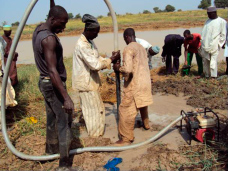  |
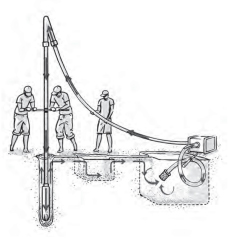  |
Rotary water jetting - Documents from the Practica Foundation |
|
Sludge drilling (sludging) (Max. depth : 35 m)
This method has been developed and become widespread in Bangladesh using bamboo pipes.
A borehole drilling string is driven manually and gradually into the ground using a lever arm and water is circulated to bring the cuttings produced by the drilling tool up to the surface.
The drilling string is operated manually from the top downwards using a sort of pole to be able to raise it again. In some cases, an operator also turns this drilling string manually to lower it more easily.
As the rods are lowered, the shock created on the ground by the bit fixed to the end of the drilling string breaks up the ground and above all fragments the materials.
To bring the cuttings to the surface, the operator plugs the upper end of the drilling string with his hand whilst another brings it up to create (valve effect) a suction of the water and the spoil it contains up to the surface. During the next downwards movement, the operator removes his hand from the drilling string and the mud spurts into a small pond dug beforehand by the side of the borehole where the spoil is deposited and where the settled water is once more injected into the borehole. The water pressure on the borehole walls and the mud prevent the walls from collapsing.
This type of sludge drilling (with or without rotation) can be used up to depths of about 35 metres.
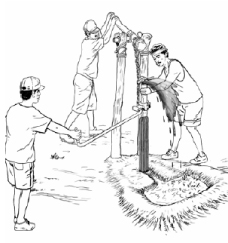  |
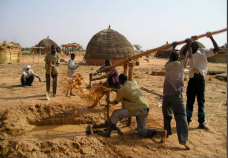  |
They are sunk :
Either by using light motor-driven means (pumps, compressors) to dig the ground
- DTH (down-the-hole hammer) drilling or rotary percussion drilling
- Rotary drilling
Or by using heavy drilling machinery that can reach great depths
Borehole sunk from a mobile drilling platform
DTH hammer drilling (or rotary-percussion drilling)
This technique combines the action of a pneumatic drill and a drill bit fitted with drilling rods with a cutting tool on their tips. This equipment is operated by compressed air. It bangs the hammer into the borehole to break and grind up the ground (percussion phase) and evacuate the cuttings towards
the outside (blowing/evacuation phase).
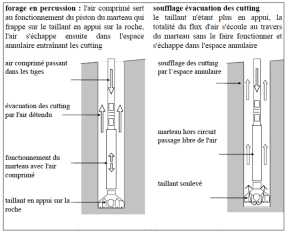

Rotary drilling
Rotary drilling uses a bit that leads a string of rapidly-turning rods with a cutting tool (three-cone or three-blade) at its bottom. This pierces the ground and is driven in under the combined effect of the thrust of the bit and the weight of the drilling string. Pressurised mud is injected inside the rods. The drilling mud prevents the walls from collapsing, consolidates them (cake) and brings the cuttings to the surface where they are deposited in a settling pond. The recycled mud is re-injected into the drilling string.
Rotary drilling is possible with light mechanised equipment, namely a motor mounted on a frame, a small compressor and a mud pump.
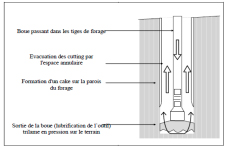 |
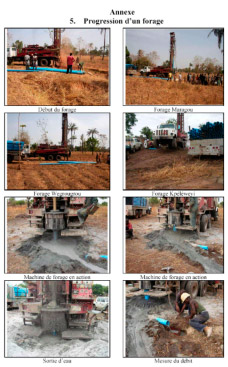 |
Principle of rotary drilling. PS EAU document
|
Progress in a borehole
|
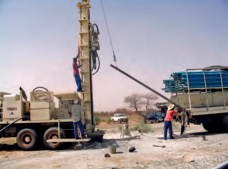
Drilling platform on truck - Photo AFD
This rotary drilling technique uses heavy piercing machinery which can reach great depths.
The machinery is mounted on large straight or tracked vehicles. It uses rotary drill equipment that pierces, chews up or breaks the rocks, of, if the ground is soft, large gimlets called augurs. The boreholes can be several hundred metres deep. A pump is often installed at the bottom of the borehole to pump the water up to the surface.
There are several models of such equipment. They are very expensive and only major companies can
have them and potentially hire them out.
It is however important to point out that some bodies or NGOs have also developed or adapted with manufacturers mechanised drilling machinery that is also mobile but which is far lighter and suitable for certain types of drilling.
Thus ACF (Action contre la faim) has developed three rotary- or DTH hammer-drilling kits (ACF-PAT 201, 301 and 401) for its boreholes. These were produced initially by the Thai company PAT and adapted (see ACF document given at the end of the sheet).
The choice between different drilling types depends on several technical parameters :
- The geological characteristics of the ground to be drilled : hard rocks, soft and crumbly rocks, sandy ground, etc.
- The depth to be reached (based on the depth of the water table)
- The flow rate required
- The diameter of the borehole :
- 50 to 140 mm for manual drilling
- 100 to 160 mm for mechanised drilling with light equipment
- Up to 1500 mm for mechanised drilling with heavy machinery
The Practica Foundation has prepared a comparison table of the main manual drilling techniques :
| Methods | Techniques | Average depth | Geology | Advantages | Drawbacks | Execution time |
| Auger | manual auger | 10 to 15 m | Sand, silt, clay (not thick), gravel (< 4 mm) | easy to use | Well casing difficult to remove from a thick layer of clay | 1 day |
| Mud | madrill, manual rotary, emas, rota sludge | 20 to 35 m | Sand, silt, clay (not thick), soft consolidated formations (alterites) | easy to use | Huge consumption of water in permeable layers of coarse sand | 2 to 4 days |
| Water jetting | jetting, washbore | 6 to 15 m | Sand and silt | quick | A large volume of water in a short period is necessary | less than one day |
| Percussion | percussion, stone hammer | 15 to 25 m | Average and hard consolidated formations (laterite, rock) | suitable for had formations | Long and high equipment costs | 1 week to 10 days |
| Motor-driven augur | Pat drill 201, rotary motor-driven | 35 to 45 m | All types of average, rock-free consolidated formations | fast in the hard layers | High water consumption, high equipment and execution cost | 1 to 5 days |
Mechanised drilling with light or heavy machinery requires professional operators, machinery and a large budget to finance the operation. These systems are therefore not suitable for rural areas in developing countries.
The DTH hammer drilling system can go through hard ground like granite or consolidated sedimentary layers (sandstone, limestone).
The rotary technique with light equipment is used in sedimentary ground whereas the heavy, platform-mounted machinery can drill through hard ground to great depths.
The cost of sinking a borehole depends significantly on materials and equipment used, the structure of the ground, the depth to be reached (i.e. the depth of the water table) and the required flow rate. It is therefore difficult to give an accurate cost for sinking a borehole, especially as the cost will also vary from one country to the next and whether or not the population provides part of the manpower on a voluntary basis.
As a rough guide, the cost of a borehole some thirty metres deep using manual techniques can be between €200 (rare case in Cambodia) to €3,000.
Manual drilling equipment can frequently be manufactured, transported and maintained locally.
For a borehole about 60 m deep drilled with mechanised equipment, the cost can range between €4,000 and €13,000 (Examples noted by Caritas : €6,500 in Ethiopia, €8,700 in Burkina Faso, €12,000 in Togo - Examples noted by ACF : €4,000 in Guinea, €13,000 in South Sudan), but these machines can drill up to 120 m deep.
There are many hybrid techniques associating those presented here. They can improve the sinking efficiency of bored wells by combining the advantages of these various methods.
It is recommended to :
- insert a preliminary well casing, at least over the first few metres for a borehole in soft ground, so that it can be finished without putting the work at risk and the walls are prevented from deforming or collapsing when the ground is unstable or when using certain percussion machinery like the DTH hammer drill.
- plan to insert the well casing (often in PVC) rapidly at the end, in principle over its full length, including when it passes through rock. If the well casing does not extend the whole way to the bottom (for example, a slight collapse or deposit of cuttings), a full pipe plugged at its base should be inserted shortened to 50 cm to 1 m less than the total depth of the borehole.
- insert gravel packing at the bottom of boreholes, which is also essential if the well casing does not reach the bottom. This is lowered along the annular space in the well casing and, when fixing the capture column, filters the water entering the perforated screen by stopping the fine particles of sand or other material.
The screen is a perforated tube inserted at the end of the well casing to capture the water from the aquifer without particles. The amount the screen is opened depends on the particle size of the capture. The gravel packing means that screens with wider perforations can be used, thereby increasing the flow rate and longevity of the borehole.
- create a coping once work has finished on the borehole to be able to fix a pump, even if this is only purchased
later on.
- construct all the other ancillary facilities for the best possible use and safety of the borehole (reinforced concrete platform, slightly sloping ditch at least 5 m long, secure perimeter, etc.).
- Mud plays an essential role in most drilling techniques. Its density and viscosity should be checked regularly during drilling as they influence the raising of cuttings and consolidation of walls (heavy mud is preferable), as should its temperature, as this lowers the temperature of the drilling tool. Additives like polycol can alter some of these parameters.
Publications in French :
- OMS/WHO : health technician manual
http://whqlibdoc.who.int/publicatio...
- ACF (Action Contre la faim) : Extract from the very well-documented book of 743 pages "Eau-assainissement-Hygiène pour les populations à risques" published on the PSEau site. This book, in terms of "borehole execution methods and equipment" (pages 253 to 312) is genuine practical guide, illustrated by diagrams and numerous examples, for initiation into miscellaneous design, execution, equipment and development techniques for boreholeshttp ://www.pseau.org/outils/ouvrage...
- AFD : Methods guide to build and manage boreholes fitted with a human-operated pump in Subsaharian Africa :
http://www.afd.fr/webdav/site/afd/s...
- Wikipedia : Chapter relating to the borehole available online here :
http://fr.wikipedia.org/wiki/Forage
- Ontario Ministry of Agriculture, Food and Rural Affairs : Private rural water supplies.
http://www.omafra.gov.on.ca/erglish...
- Practica Foundation : it has produced a series of very detailed and educational training manuals on the main manual borehole techniques :
Manual auger http://www.unicef.org/wash/files/05...
Water jetting http://www.practica.org/wp-content/...
Percussion drilling http://www.practica.org/wp-content/...
Knowledge of underground water capture methods applied to manual boreholes http://www.unicef.org/wash/files/04...
Publications in English :
- WEDC (Water Engineering and Development Centre, Lougborough University) has carried out a summary comparison of simple borehole techniques.
https://www.lboro.ac.uk/orgs/well/resources/technical-briefs/43-simple-drilling-methods.pdf
- WELL, Water, Sanitation and Environmental Resources Centre, University of Loughborough, Leicestershire (UK) has published a large number of interesting illustrated technical sheets featuring water and sanitation, including sheet 43 "Simple drilling methods". Available online at :
https://www.lboro.ac.uk/orgs/well/resources/technical-briefs/43-simple-drilling-methods.pdf
- The English NGO WaterAid has published about fifteen interesting illustrated Technology Notes on miscellaneous topics stating the respective disadvantages and drawbacks of each method, including no. 6 (pages 11 to 14) covers hand-dug wells and no. 7 (pages 15 to 20) bored wells. Available online at :
http://www.wateraid.org/what-we-do/...
- YouTube : Creation of a sludge borehole for a well in Madagascar
http://www.youtube.com/watch?gl=NL&...
- VIMEO : this shared site gives access to a certain number of videos (in English) on building a well prepared by the Bolivian NGO EMAS (Escuela Móvil de Agua y Saneamiento - Mobile School for Water and Sanitation). This NGO puts together good value training programmes and solutions for access to drinking water in many countries.
http://vimeo.com/channels/emas